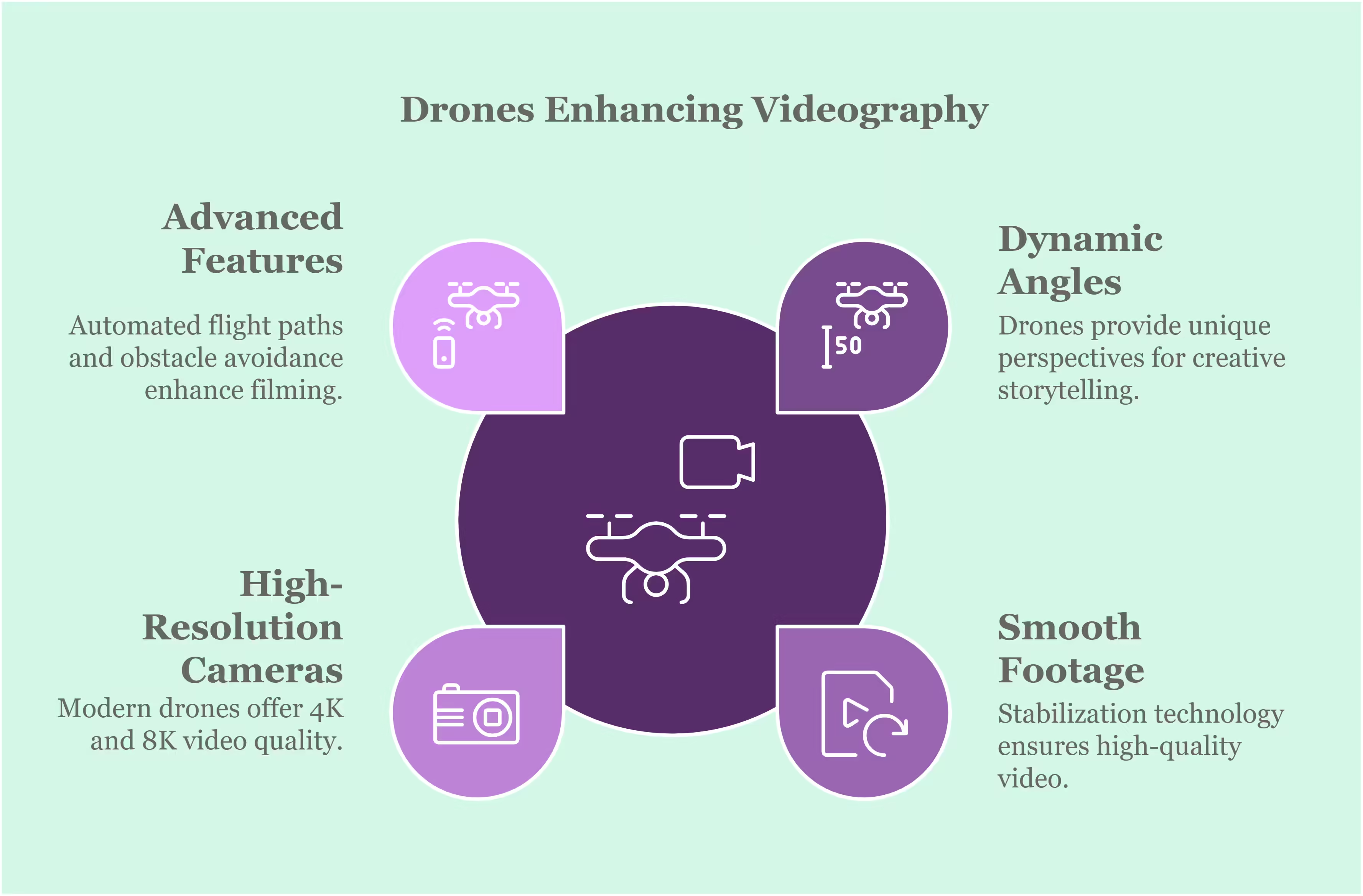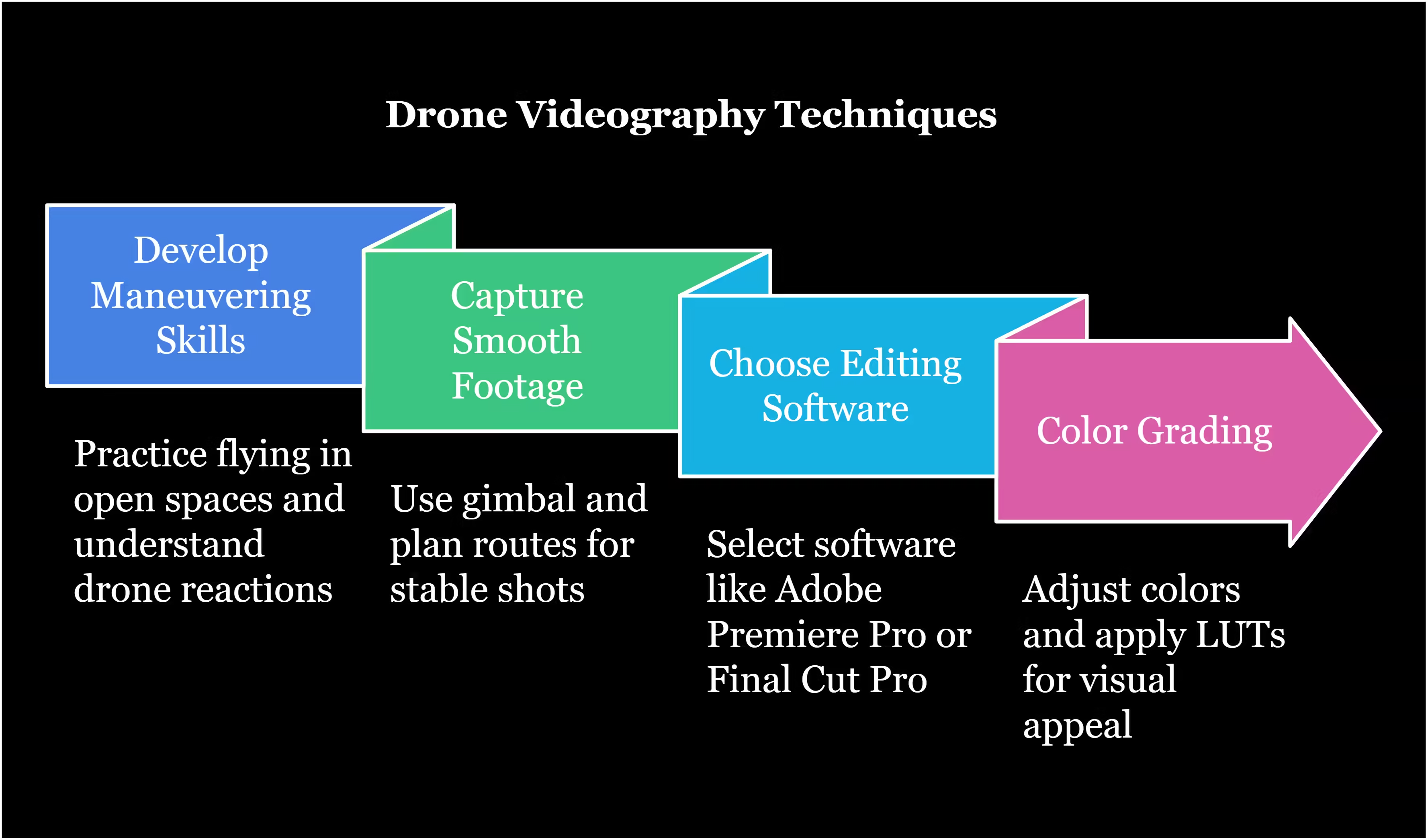Drones revolutionize professional videography by offering dynamic angles and smooth footage. They enhance creativity and storytelling in visual content.
Drones for professional videography have become essential tools for filmmakers and content creators. These devices provide unique aerial perspectives, capturing stunning visuals that were previously unattainable. Modern drones come equipped with high-resolution cameras, stabilization technology, and intuitive controls. They allow videographers to shoot in 4K or even 8K, ensuring crystal-clear video quality.
Compact and portable, drones can access hard-to-reach locations, adding a new dimension to visual storytelling. They also offer advanced features like automated flight paths, obstacle avoidance, and real-time video transmission. Investing in a quality drone can significantly elevate production value and open up creative possibilities.
Introduction To Drones In Filmmaking
Drones have transformed the world of professional videography. Filmmakers can now capture stunning aerial shots. These shots were once costly and difficult to achieve. This technology allows for creativity and innovation in filmmaking.
Historical Context
Drones were initially used by the military. Their primary purpose was surveillance and reconnaissance. Over time, their use spread to other fields. Filmmaking saw the potential of drones early on. The first drone cameras were bulky and expensive. Only big-budget films could afford them.
By the early 2000s, technology began to improve. Drones became more accessible to independent filmmakers. This shift allowed for more creative storytelling. Aerial shots became a staple in films and documentaries.
Modern Advancements
Today’s drones are lightweight and user-friendly. They come equipped with high-resolution cameras. Many also feature advanced stabilization systems. This ensures smooth and steady footage.
Modern drones offer various shooting modes. These include follow-me, orbit, and waypoint. These modes make complex shots easier to execute. Filmmakers can focus on creativity rather than technical challenges.
Some drones even have obstacle avoidance systems. This technology prevents crashes and ensures safety. Drones can now fly longer distances and for extended periods. This allows for more extensive and dynamic shots.
| Feature | Early Drones | Modern Drones |
|---|---|---|
| Camera Quality | Low Resolution | High Resolution |
| Stability | Poor | Advanced Stabilization |
| Accessibility | Expensive | Affordable |
| Flight Modes | Basic | Multiple Modes |
Drones have opened up new possibilities in filmmaking. They provide unique perspectives and enhance storytelling. As technology continues to evolve, so will their impact on videography.
Choosing The Right Drone
Choosing the right drone for professional videography can be challenging. There are many options available, each with different features. Your choice will depend on your budget and technical needs. Let’s break down the key aspects to help you make an informed decision.
Budget Considerations
Budget is crucial when selecting a drone. Here are some points to consider:
- Entry-Level Drones: Ideal for beginners. Cost ranges from $300 to $800.
- Mid-Range Drones: Suitable for intermediate users. Prices range from $800 to $1500.
- High-End Drones: Best for professional videographers. Expect to pay $1500 and above.
Consider your needs and how much you are willing to invest. Remember, higher-priced drones often offer better features and durability.
Technical Specifications
Technical specifications are essential for quality videography. Here are the main specs to look for:
| Specification | Details |
|---|---|
| Camera Quality | Look for 4K resolution or higher for crisp footage. |
| Battery Life | Choose drones with at least 20 minutes of flight time. |
| Stabilization | Opt for drones with gimbal stabilization for smooth videos. |
| Range | A good range is 2 miles or more for expansive shots. |
| Flight Modes | Look for intelligent flight modes like Follow Me and Orbit. |
These specifications will ensure you capture high-quality videos. It’s important to balance your budget with these technical needs.
Essential Features For Videography
Drones are revolutionizing professional videography. They offer unique perspectives and stunning visuals. Understanding the essential features for videography helps in choosing the right drone. This section delves into the key features needed for professional videography.
Camera Quality
The camera quality is crucial for professional videography. A high-resolution camera captures detailed images and videos. Look for drones with at least 4K resolution. Many professional drones offer advanced camera settings. These include adjustable aperture and ISO levels. A good camera sensor enhances image quality in low light.
Consider the following camera features:
- Resolution: 4K or higher
- Frame Rate: 60fps or higher
- Sensor Size: Larger sensors for better low-light performance
- Lens Options: Interchangeable lenses for versatility
Stabilization Technology
Stabilization technology ensures smooth and stable footage. It is essential for professional videography. Drones often use gimbals for stabilization. A 3-axis gimbal offers the best stability. It compensates for drone movements in all directions. Some drones also feature electronic image stabilization. This further enhances video smoothness.
Key stabilization features to look for:
- 3-Axis Gimbal: Provides superior stability
- Electronic Image Stabilization: Reduces vibrations
- Anti-Vibration Mounts: Minimizes mechanical vibrations
Choosing a drone with these features ensures high-quality videography. The right camera quality and stabilization technology make a significant difference. They help in capturing professional-grade videos effortlessly.
Pre-flight Preparation
Pre-flight preparation is crucial for professional videography using drones. This stage ensures a smooth and successful shoot. Proper preparation saves time, reduces risks, and enhances video quality. Below, we cover key aspects of pre-flight preparation.
Location Scouting
Location scouting is the first step. Identify potential locations that fit your project. Use online maps and local knowledge to find the best spots. Consider the following factors:
- Accessibility
- Legal permissions
- Safety
- Scenic value
Visit the location if possible. Check for obstacles like trees, buildings, and power lines. This ensures a safe flight path for your drone.
Weather Conditions
Weather conditions greatly affect drone flights. Always check the weather forecast before planning your shoot. Important factors include:
| Factor | Impact |
|---|---|
| Wind | Strong winds can make flying difficult. |
| Rain | Most drones are not waterproof. |
| Visibility | Fog and low light reduce visibility. |
Ideal weather conditions are clear skies and light winds. This ensures stable and safe flights for high-quality footage.
Flight Techniques And Tips
Drones have revolutionized professional videography, offering stunning aerial shots. Mastering flight techniques and tips is key to capturing amazing footage. In this section, we’ll explore crucial aspects of drone flight.
Maneuvering Skills
Developing effective maneuvering skills is essential for professional videography. Practice flying in open spaces. Understand how your drone reacts to different commands. This helps in achieving precision. Use the drone’s simulator mode if available. It’s a safe way to learn controls.
- Practice flying in various weather conditions.
- Learn to hover steadily at different altitudes.
- Perform smooth turns and gentle ascents/descents.
Focus on mastering these basic moves. They form the foundation for advanced techniques. Always be aware of your surroundings. Avoid obstacles and maintain line-of-sight with the drone.
Capturing Smooth Footage
To capture smooth footage, stabilization is key. Use a gimbal to stabilize your camera. Adjust the drone’s speed settings. Slow speeds result in more stable shots.
- Start with slow, steady movements.
- Avoid sudden jerks and rapid changes in direction.
- Use cinematic flight modes if available.
Plan your flight path before take-off. Pre-planned routes help in capturing consistent footage. Use the drone’s GPS features for precise navigation.
Utilize the table below for quick reference:
| Tip | Description |
|---|---|
| Maintain Steady Speed | Helps in avoiding shaky footage. |
| Use Gimbal | Stabilizes the camera for smooth shots. |
| Pre-Plan Routes | Ensures consistent and predictable footage. |
Incorporate these flight techniques and tips in your videography. It will elevate the quality of your drone footage. Happy flying!
Post-production Workflow
Drones have transformed professional videography. The magic happens in the post-production workflow. This phase is essential for turning raw footage into a polished masterpiece. Here’s how you can streamline your post-production process.
Editing Software
Choosing the right editing software is crucial. Popular options include Adobe Premiere Pro, Final Cut Pro, and DaVinci Resolve. These tools offer powerful features for cutting, trimming, and organizing your footage.
Adobe Premiere Pro is known for its user-friendly interface. It supports a wide range of file formats. Final Cut Pro is optimized for Mac users. It offers smooth performance and advanced features. DaVinci Resolve excels in color grading but also provides robust editing tools.
| Software | Key Features |
|---|---|
| Adobe Premiere Pro | User-friendly, supports many file formats |
| Final Cut Pro | Optimized for Mac, advanced features |
| DaVinci Resolve | Excellent color grading, robust editing |
Color Grading
Color grading enhances the visual appeal of your footage. It involves adjusting the colors to achieve the desired mood. This step can transform a good video into a great one.
Start by balancing the exposure. Ensure the highlights and shadows are well-adjusted. Next, correct any color imbalances. Use tools like color wheels, curves, and LUTs (Look-Up Tables). DaVinci Resolve is highly recommended for this task.
Follow these simple steps for effective color grading:
- Balance the exposure.
- Correct color imbalances.
- Apply LUTs for a consistent look.
Investing time in color grading can significantly improve the quality of your video. Your audience will appreciate the professional look and feel.
Legal And Safety Considerations
When using drones for professional videography, it’s crucial to understand the legal and safety considerations. Adhering to regulations and ensuring proper insurance can protect both your equipment and your business.
Regulations
Different countries have different drone regulations. Always check local laws before flying. In the U.S., the FAA governs drone use. You must register your drone if it weighs over 0.55 pounds. Commercial drone operators need a Part 107 certification.
Always fly your drone within your line of sight. Avoid flying near airports or crowded areas. Respect people’s privacy by not flying over private property without permission.
| Country | Regulations |
|---|---|
| USA | FAA Part 107, drone registration |
| UK | CAA registration, drone operator ID |
| Canada | Transport Canada drone license |
Insurance
Having drone insurance is vital for professional videography. It covers damage to your drone and third-party liabilities. Many companies offer drone-specific insurance plans.
- Liability Insurance: Covers damage to other people’s property.
- Hull Insurance: Covers damage to your own drone.
- Personal Injury: Covers injuries to people caused by your drone.
Some clients may require you to have insurance before hiring you. Always check the policy details carefully. Ensure it covers all aspects of your drone operations.
Insurance can also cover data loss. This is useful if you’re filming crucial footage.
Future Trends In Drone Videography
Drones have revolutionized the world of professional videography. Their popularity continues to grow. New trends in drone videography are emerging. These trends promise to transform the industry.
Technological Innovations
Technological innovations drive the future of drone videography. These innovations improve video quality and ease of use.
- AI Integration: AI helps drones to fly smarter. AI enhances object tracking and scene recognition.
- Advanced Stabilization: New stabilization technologies ensure smooth, stable footage. Even in windy conditions, drones capture clear videos.
- Longer Battery Life: Improved batteries allow longer flight times. Videographers can shoot more without frequent recharges.
- Enhanced Sensors: High-resolution sensors capture more detail. They improve video quality, even in low light.
Industry Predictions
Experts predict significant changes in the drone videography industry. These changes will shape how professionals use drones.
- Increased Use in Film Production: Drones will be essential in film-making. They provide unique angles and shots.
- Real Estate Marketing: Drones offer dynamic property views. They help realtors showcase listings better.
- Sports Coverage: Drones capture live sports from unique perspectives. Fans get an immersive experience.
- Environmental Monitoring: Drones will aid in tracking environmental changes. They provide valuable data for research.
These trends show a bright future for drone videography. Stay updated to leverage these advancements.
Frequently Asked Questions
What Are The Best Drones For Videography?
The best drones for videography include DJI Mavic 3, Autel EVO II, and Skydio 2. These models offer superior camera quality, stability, and advanced features suitable for professional use.
How Long Can Professional Drones Fly?
Professional drones typically offer a flight time of 20 to 40 minutes. Battery life varies by model and usage conditions, so always check specifications before purchasing.
Do Drones Need Special Licenses?
In many countries, professional drone operators need a special license. In the U. S. , the FAA requires a Part 107 certification for commercial use. Always check local regulations.
Can Drones Shoot In 4k Resolution?
Yes, many professional drones can shoot in 4K resolution. Models like DJI Phantom 4 Pro and Autel EVO II provide high-quality 4K footage, perfect for videography.
Conclusion
Drones have revolutionized professional videography. They offer unique angles and dynamic shots that were once impossible. Investing in a quality drone can elevate your video projects. Embrace this technology to stay ahead in the competitive world of videography. Explore the potential of drones and take your creativity to new heights.




